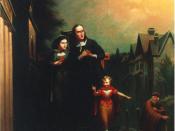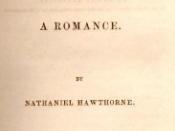Nathaniel Hawthorne uses Hester Prynne, Arthur Dimmesdale, and Roger Chillingworth to portray that everyone may sin, but every sinner has the chance for redemption. The book in which he portrays this is entitled The Scarlet Letter, A book set in New England in the 1600s, about the aforementioned characters, their sins, and their redemption or lack thereof.
Hester Prynne is the book's protagonist. Her sin is committing adultery with Dimmesdale. She becomes impregnated by this act and so is forced by the Puritans to wear a scarlet "A" on her chest, standing for "adulteress." The Puritans scorn Hester because of her sin. Hester's daughter, Pearl, Is scorned because she is the other symbol of Hester's sin. Hester redeems herself by admitting to her crime and suffering like a good Puritan should, and never running away from her punishment. Due to her acting as a good Puritan, she suffers less than anyone else and is shown as achieved redemption.
Arthur Dimmesdale is the person who Hester commits her adultery with. He suffers more than Hester because he whips himself and can't admit his sin because he's a coward, which strains him intellectually. The only hope for redemption is, seconds before dying, he admits his sins by climatically opening his shirt, revealing an "A" scarred on his chest. He lets Hester suffer publicly while he suffers privately, his fate is debatable.
Roger Chillingworth is this novel's demon. His sins are as follows: sinful hate, not believing in God due to being a scientist, the inability to forgive, and needing facts to believe something. He becomes consumed with torturing Dimmesdale, losing all semblances of a normal life and suffering due to his inability to stop. He is the only character in the novel to have no redeeming action. He dies shortly after...


